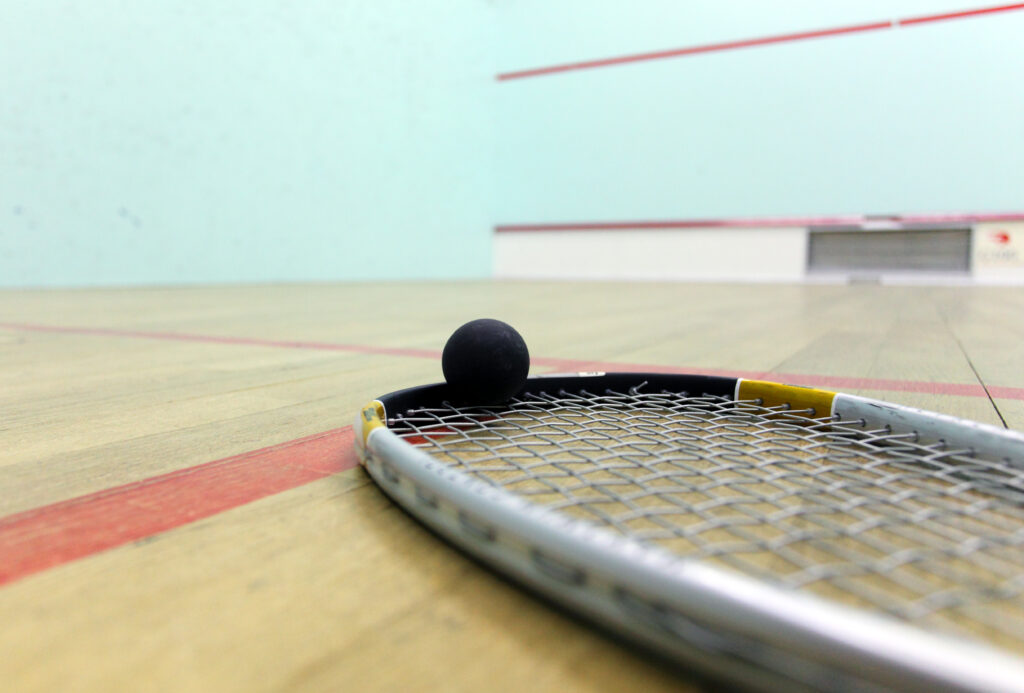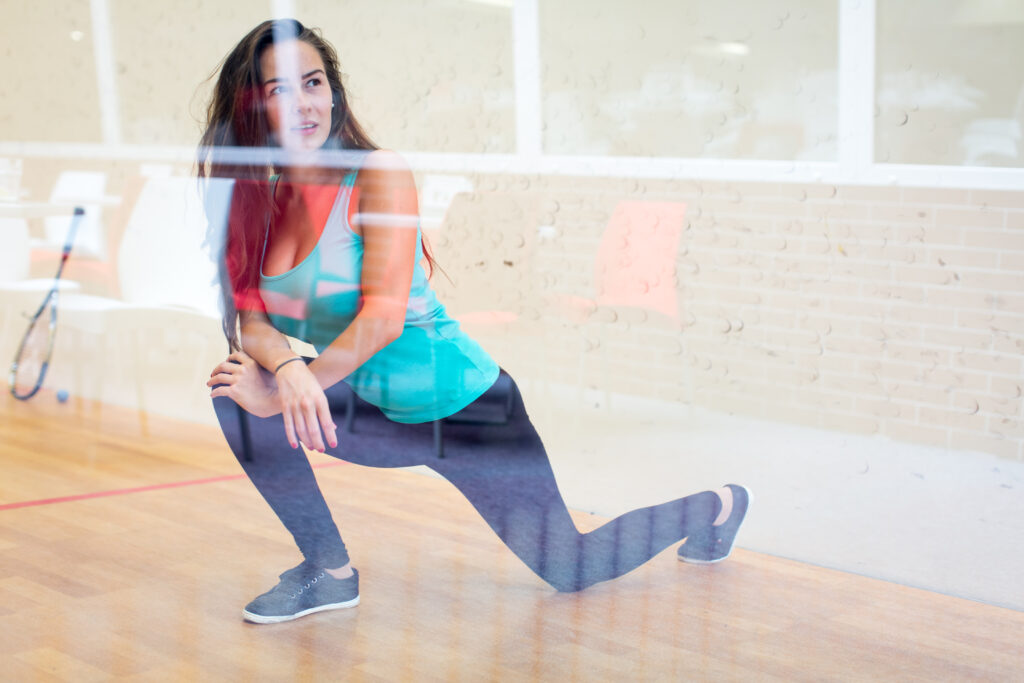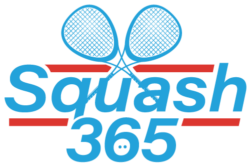
When you’re a beginner at any sport, the most challenging part is always where to start. By following these squash exercises for beginners, you’ll be on your way from a beginner to advanced in no time.
Questions abound; questions like, what kind of drills should I be doing? How many times per week? What’s the duration of the drills? Should I be taking lessons? What about exercising? The list could go on and on.
As an expert coach in High-Performance sport, two of the most common problems I see beginners make are warming up incorrectly or, not at all, and no plan for the training session.
Most amateurs jump straight out on the court and start playing; no warm-up, no stretching, and no plan.
I see this all too often, and unfortunately, it generally leads to players becoming frustrated, invariably becoming injured, and in the end, dropping out of the sport.
This article will share some tips and pointers that will help make your start in Squash easy, motivating, and enjoyable. I have implemented these strategies into the training programs of professional athletes for nearly 20 years.
Warm-Up Squash Exercises for Beginners
We’ve all heard of the old adage ‘Keep It Simple.’ Well, guess what, it applies to warming up too. Professional players keep their warm-up routines incredibly simple; nothing too fancy, and what’s good for the goose is good for the gander.
As a beginner, the warm-up exercises you’ll be doing are ones you’ve most certainly performed before.
I won’t provide you with any “hard and fast” rules, but rather give you some exercises to choose from, so you can create a warm-up routine that’s right for YOU!
- Skipping Rope
- Running
- Stationary Bike
- Therabands
- Jump Squats and Star Jumps are just a few to get you started.
Your warm-up should last no longer than 15 minutes or until you start to feel some sweat across your brow. You can perform one of these or a combination, but it doesn’t really matter; the main thing is you’re warmed up and ready to go.
Stretching: Dynamic Or Static?
Another recent trend which beginners to the sport might not be aware of is “Dynamic Stretching”, basically it’s the opposite of “Static Stretching,” which almost everyone is familiar with.
Dynamic stretching is an excellent way to get the body moving. Research has shown that performing dynamic stretching before playing sports is incredibly beneficial for the athlete and may drastically reduce the chance of injury.
This strategy also carries over to the gym and weight training. Numerous studies have shown that performing dynamic stretching instead of static stretching before exercise can improve performance and again help keep injury at bay.
This doesn’t mean there’s not a place for static stretching; there is.
One of the best habits you can get into is static stretching immediately after playing. Even just 10-15 minutes can help the recovery process, prevent muscles from cramping and lessen the chance of injury.

Fitness Training
When playing any sport, particularly Squash, ensuring that your base fitness is at a reasonable level is paramount. Here’s some exercise to get you started.
Cycling
Why cycling, you might ask? Well, cycling has two main benefits for Squash: its “low impact,” meaning it won’t take a toll on your body, and it strengthens your hamstrings.
Having strong hamstrings is critical when playing Squash as they allow you to explode repeatedly to chase down the ball. Performing 15-30 minutes of cycling a day should be ample, especially when starting out.
Running, Jogging, And H.I.I.T.
As you are probably aware, Squash is played on a small court in confined spaces.
Running and performing H.I.I.T or High-Intensity Interval Training is an excellent way to build endurance and speed simultaneously. Start by implementing small bursts of high-intensity sprints when you’re out for your run or on the treadmill.
You only need to sprint for 5-10 meters, which will simulate the type of distances you’ll perform while playing Squash.
These repeated sprints and stops also help develop hamstring strength which is vital for performance.
Drills Squash Exercises for Beginners
As with the warm-up, Keep It Simple reigns supreme again. You want to ease into Squash, get an understanding of the size of the court, the weight of the racquet and ball, and the speed and intensity of play.
Shadow Moving or Ghosting
Shadow moving or ghosting refers to playing the strokes and patterns of Squash but without a ball or partner. Shadowing is an excellent way to increase fitness, improve footwork, and, most importantly, start to understand the patterns of play.
Understanding the patterns of play is one of the reasons the pros look so fast. Don’t get me wrong, they’re quick on their feet, but because they understand the patterns, they can anticipate play and position themselves accordingly.
You can also shadow with a partner; Just be sure to agree to perform 5-6 points each, and then rotate.
Utilize The Wall
The best training partner you will ever find is the wall. It doesn’t talk back, it’s never late, it doesn’t sweat or smell, and most importantly, it never misses.
The same is true for other racquet sports like tennis; You’re never going to beat the wall, and that’s why it makes the perfect partner for any level of player. Start by simply allocating 10-15 minutes for each side, forehand, and backhand.
Another benefit of the wall is that it puts the ball in the same spot every time. Practicing against the wall improves consistency and helps your stroke development;
Most racquet sports are “repeat sports.” Meaning, the more you can repeat the same stroke, the less likely you are to miss.
Basic Drive-Cross-Drive Drill
This basic drill is an excellent way to get yourself accustomed to the types of movement and strokes you’ll be playing regularly.
- Player A positions near the forehand side of the court, while player B is on the backhand side close to the service box.
- Player A plays a forehand drive to themselves and then hits crosscourt to player B, who hits a backhand drive and directs the ball back to player A.
Movement is limited in this drill, but it provides you with a chance to focus on your stroke and get a feel for the ball.
Another simple variation on this drill is to have both players near the service box and hit crosscourt shots to each other. This drill is excellent at helping early racquet preparation and control; Be sure to change positions every 2-3 minutes to ensure you’re practicing both forehands and backhands.

Game, Set, Match
Well, there you have it. These simple yet effective drills, stretches, warm-ups, and exercises are designed to start you on your journey into Squash. If you follow these modest squash exercises for beginners, you’ll improve your game, increase your fitness, have fun and avoid unnecessary injury.
Remember, never be embarrassed by your level of play. Everyone has to start somewhere.
So get out there, work up a sweat, meet new friends, and enjoy the wonderful game of Squash!
